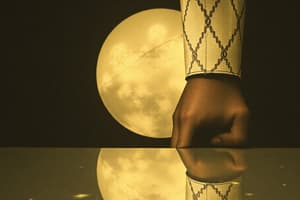Podcast
Questions and Answers
What does Law I of reflection state?
What does Law I of reflection state?
- The angle of reflection is always less than the angle of incidence.
- The angle between the incoming light and the reflected light remains constant.
- The angle between the incident light and normal line remains constant when reflected. (correct)
- Light reflects off surfaces at the same place it strikes them.
Which type of reflection occurs at smooth surfaces like mirrored glass?
Which type of reflection occurs at smooth surfaces like mirrored glass?
- Complex Reflection
- Specular Reflection (correct)
- Diffuse Reflection
- Regular Reflection
In Law II of reflection, what happens if a light source moves further away from a mirror?
In Law II of reflection, what happens if a light source moves further away from a mirror?
- The position of the reflected image changes.
- The image moves farther from the centerline without changing size, position, nor orientation. (correct)
- The size of the reflected image increases.
- The color of the reflected image changes.
What characterizes Specular Reflection?
What characterizes Specular Reflection?
How does Diffuse Reflection differ from Specular Reflection?
How does Diffuse Reflection differ from Specular Reflection?
What distinguishes diffuse reflection from specular reflection?
What distinguishes diffuse reflection from specular reflection?
Why does a plane mirror not form real images?
Why does a plane mirror not form real images?
How does diffuse reflection impact the appearance of objects compared to specular reflection?
How does diffuse reflection impact the appearance of objects compared to specular reflection?
What is a significant application of plane mirrors?
What is a significant application of plane mirrors?
How can multiple plane mirrors be utilized to distort reality according to one's imagination?
How can multiple plane mirrors be utilized to distort reality according to one's imagination?
Flashcards are hidden until you start studying
Study Notes
Exploring Reflection in Physics
Reflection is a fundamental process where light interacts with surfaces and gets redirected away from its original path. In this context, we'll delve into several facets of reflection, particularly focusing on laws of reflection, different types of light reflection, and their applications involving planar mirrors.
Laws of Reflection
The laws of reflection describe how light rays behave when they encounter a smooth surface:
- Law I: The angle between incident light and normal line to the reflecting surface remains constant when reflected. This means if you draw a perpendicular line (normal) from the point of incidence to the mirror surface, it forms equal angles with both the incoming ray and outgoing reflected ray.
- Law II: Light reflects off surfaces at the same place it strikes them. If a light source moves further away from a mirror, its image will move farther from the centerline of reflection without changing size, position, nor orientation.
These two rules govern all reflections regardless of whether the surface is polished metal or plain glass.
Types of Light Reflection
When dealing with reflection, one can distinguish three primary forms:
-
Specular Reflection: Occurs at smooth surfaces like mirrored glass. Here, the reflected light goes back along the same direction from which it arrives, creating a sharp, bright image that shows detail such as edges and colors accurately.
-
Diffuse Reflection: Happens at rough surfaces like paper or walls. Unlike specular reflection, diffuse reflection scatters light in many directions, making objects appear fuzzy and muted due to the broad range of viewing angles.
Both of these kinds of reflections conform to the laws of reflection discussed above. However, only specular reflection reverses the direction of light while keeping its initial properties unchanged, like color. Diffuse reflection alters the properties of light, making it more difficult to identify specific characteristics through observation alone.
Plane Mirrors
A significant application of reflection occurs using flat mirrors (plane mirrors). These simple tools enable us to observe images formed by reflection and understand mirror symmetry, among other uses:
- Plane mirrors produce virtual images that appear behind the mirror. Their magnification equals -1 (-ve signifies that the image is flipped horizontally), meaning they always create a smaller version of the object.
- A plane mirror cannot form real images because there's no point beyond itself where converging paths meet; rather, it simply produces more vivid views of existing surroundings.
- By stacking multiple plane mirrors, it becomes possible to construct larger images or distort reality according to one's imagination.
In summary, reflection plays a pivotal role in understanding the behavior of light and is essential to comprehending phenomena such as imagery formation, mirror symmetry, and various optical devices operation principles.
Studying That Suits You
Use AI to generate personalized quizzes and flashcards to suit your learning preferences.




